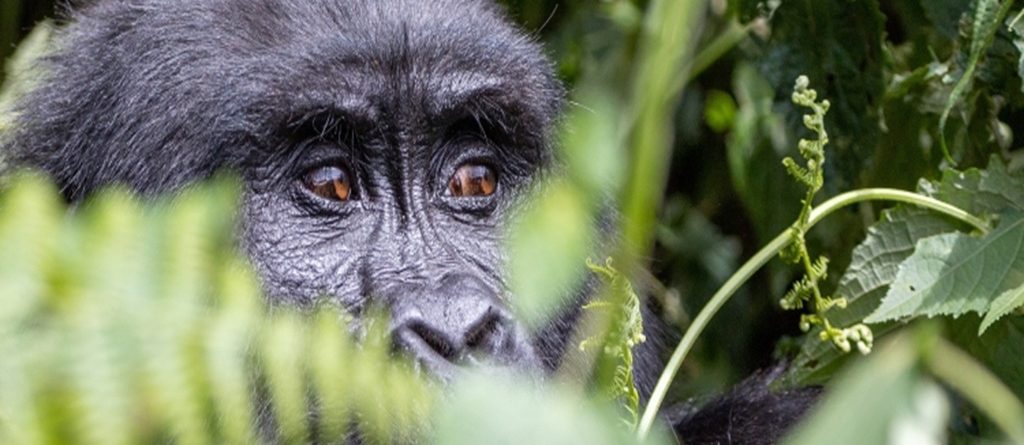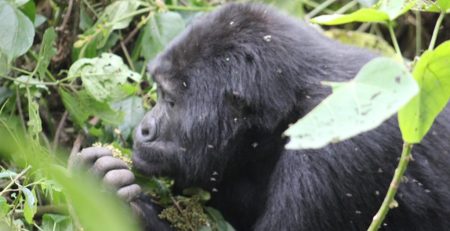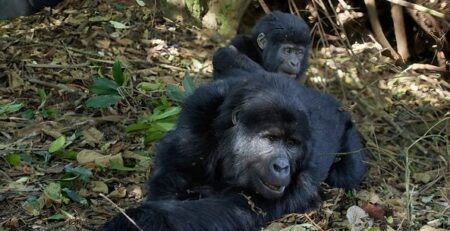Gorilla Trekking Guidelines
Bujuku Eco Tours2025-09-24T19:39:33+03:00Gorilla trekking guidelines (rules and regulation) you should put into consideration before, during, and after interacting with gorillas. The guidelines for gorilla trekking aren’t different in Uganda, Rwanda, and the Democratic Republic of Congo. Briefing is usually conducted on the gorilla trekking guidelines before visitors begin their day search for gorillas. This is done by respective park officials in Bwindi Impenetrable National Park, Mgahinga (in Uganda), Volcanoes National Park, Rwanda, Congo’s Virunga and Kahuzi-Biega National Park.
List of gorilla trekking guidelines to observe in Bwindi, Mgahinga, Volcanoes, Kahuzi-Biega & Virunga National Parks.
Guidelines to know before you depart for actual gorilla trekking
- The park authorities only allow up to 8 tourists to visit one habituated group of gorillas in a day. This guideline is intended to reduce any likelihood of behavioral disturbance to the gorillas and also possible exposure to infectious human-borne diseases.
- A visitor shouldn’t expect to proceed to track gorillas if he or she shows symptoms of a cold/other infectious diseases. This guideline is useful to all trekkers to observe, as it protects gorillas from any danger of contracting infectious diseases.
- In order for you to officially proceed to visit gorillas in Bwindi, Mgahinga, Virunga or Volcanoes, you must show a valid gorilla permit. The valid permit offers you a chance to be part of the team embarking on the search for gorillas. Everyone who is interested in seeing mountain gorillas should have a permit, which should be obtained in advance.
- Visitors must disinfect themselves before you officially enter the forest to see gorillas.
- A visitor can only be allowed to join others in the search for gorillas if he or she is above 15 years. This is the standard eligibility age limit to be observed by all visitors on gorilla tour in Uganda, Rwanda, and Congo.
Guidelines to observe on your way to find gorillas in Bwindi & other Parks
- Be attentive and ensure that your voices are kept extremely low. Minimizing your voice doesn’t mean you shouldn’t interact. Visitors have the freedom to interact among themselves and also ask questions for clarification. The advantage of having your voices kept low is, it enables you to enjoy sights of other species and not disrupt gorillas in their natural habitat.
- If you are wearing a facemask, it is recommended to have short breaks during the trek to allow you to grasp some fresh air. This is true with higher altitude hikes.
- Littering the habitat of gorillas is 100% not allowed, and this practice must be observed by all visitors on gorilla trekking. If you have used items, it is advisable to return them to the park offices, then dump them to the designated containers. Leaving the used containers in the forest can pose a risk of spreading infectious diseases to gorillas and other species.
Guidelines to observe when with gorillas in the wild
- When you finally come across a group of gorillas, expect to spend a maximum of only 1 hour with these apes. The one hour is to be spent observing gorillas, taking photos, and learning so much about the behaviors of these great apes.
- Avoid unnecessary movements that can make gorillas get irritated.
- Visitors must stay 8-10 meters away from gorillas. At times, gorillas come close to you, but you are advised to try as much as you can to maintain a distance and not to make eye contact with them. Maintaining a distance from these apes allows you to enjoy a great view of them while they are relaxed or calm.
- When you get close to gorillas, smoking, drinking, eating shouldn’t be done. Gorillas can grab what you have in your hand, and that means you pose a higher risk for these endangered species to get infected.
- Be aware that gorillas, like humans, can charge, and in the event that this happens, you are expected to observe the safety measures shared by your park ranger guide. It is a tempting moment, but what you shouldn’t do is try running away. Trying to run away means you increase the possibility of these apes following you, thinking you are an enemy that has intruded on their territory.
- Taking pictures with gorillas- photography is a must-do thing during gorilla trekking, but ensure that you use a flash-free camera. The advantage of cameras with no flash is that gorillas won’t get scared.
- Visitors are not allowed to have body contact with gorillas. Keep your hands off gorillas, even when they come trying to rub themselves on you.
Health guidelines to observe during gorilla trekking
- Once you have helped yourself (defecated), it is recommended that you have your waste buried deep in the ground at least 30cm deep. The wastes should be properly covered in a way that gorillas or any other animal can’t open.
- Social distance –it is recommended to maintain a distance of 8-10m from gorillas to reduce the chances of spreading diseases from humans to these apes or vice versa.
- A maximum carrying capacity per gorilla group still stands at 8pax and should be respected.
- Cover your mouth to allow you to cough safely or cover your nose when in need to sneeze. This is to protect gorillas from contracting the bacteria or viruses causing infectious diseases.
Gorillas in Uganda, Rwanda, and Congo –brief facts
About 1063 endangered mountain gorillas exist in the wild, and they occupy only Uganda, Rwanda, and Congo. The highest population of them is in Uganda, while the remaining portion resides in the Virunga Mountains. Gorillas in Uganda, Rwanda, and Congo can be tracked in their families, and each family is led by a mature silverback gorilla.
Places to visit to see gorillas include Bwindi Impenetrable National Park, which is in the Southwestern Uganda. This Park is sitting on an area of 331 sq. km and has varying elevations of 1160-2607m. It is a recognized UNESCO site, it gained the status since 1994, and today, this Park features over 24 habituated families that exist in its varying gorilla trekking sectors. Bwindi is composed of 4 sectors, including Buhoma, Nkuringo, Rushaga, and Ruhija.
Mgahinga is spectacularly located in Kisoro, southwestern Uganda, and is the smallest Park in the Virunga region and Uganda at large. Covering only 33.7 sq. km, Mgahinga offers amazing gorilla encounters, and the Nyakagezi group is the only family you should expect to visit.
Gorilla trekking permits in Bwindi or Mgahinga are available for reservation at USD 800 per person for foreign non residents, the foreign residents pay USD 700 while East African citizens obtain their Uganda gorilla permits at UGX 300,000 per person.
Volcanoes National Park, Rwanda, gorilla treks involve exploring the 13 habituated groups of mountain gorillas. Visitors start their day searching for the Rwanda gorillas from Kinigi, but you should have a valid permit, each costing USD 1500 per person for all visitor category.
Congo gorilla treks offer mountain gorilla and lowland gorilla trekking encounters. To see Congo mountain gorillas, you should expect to visit the Virunga National Park in the eastern end of the country. The Eastern lowland gorilla encounters are possible in Kahuzi-Biega National Park. Mountain gorilla and Eastern lowland gorilla encounters are possible in Congo provided that you have a valid permit each open for booking at USD 400 per person.
Preparations for a gorilla trekking adventure
Pack appropriately and start with essential gear/items. The packing list should comprise of waterproof hiking boots, bottled drinking water, long-trousers, a first aid kit, long-sleeved shirts, a pair of gardening gloves, a tin of insect repellent, snacks, a camera, and others.












Leave a Reply